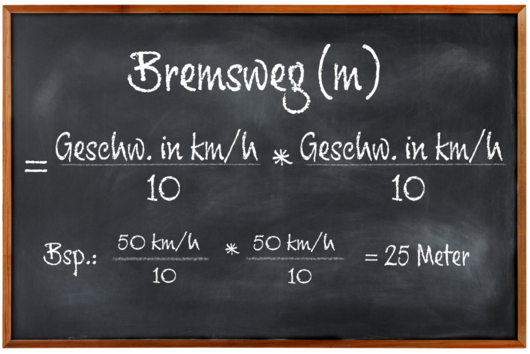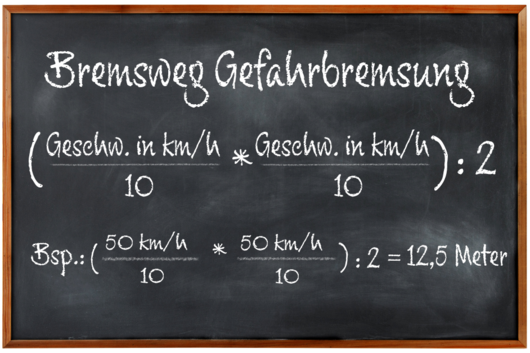The braking distance
One of the most important formulas during your driver's license training is the calculation of the stopping distance. This consists of reaction distance and braking distance.
In this article we explain what the braking distance is and how the calculation of a "normal braking" and a " hazard braking" differ from each other. You can easily calculate both yourself with a rule of thumb.
Definition of the braking distance
The braking distance is defined as the distance from the start of braking to the point where your car stops.
How long this takes depends on many factors such as the grip of the tyres on the road or the braking system of the vehicle.
You can calculate the braking distance with a simple rule of thumb. Although it does not take into account the above factors, it is accurate enough to calculate the braking distance in general.
However, it is important to know that there are two different types of calculation: A distinction is made between "normal braking" and "hazard braking".
Normal braking
This is how you calculate it
As already mentioned above, the following rule of thumb serves as orientation. Please always note that the actual braking distance always depends on the road surface, the condition of the road, the vehicle and the amount of braking. For example, the braking distance can be significantly increased by ice on the road, a bad condition of the brakes or worn tyres and can deviate greatly from the calculated result.
You can calculate the braking distance with the following rule of thumb:
Braking distance (m) = (speed in km/h : 10) x (speed in km/h : 10)
An example:
At 50 km/h you stop your car after 25 m during normal braking, because (50 km/h : 10) x (50 km/h : 10)= 25 m

The hazard braking
This rule of thumb applies
In the event of a hazard braking situation, the formula can be modified slightly. The brake pedal is depressed with full force during a hazard braking manoeuvre. Here the calculated braking distance is divided by 2. This results in the following formula:
[(Speed in km/h : 10) x (Speed in km/h : 10)] / 2 = Braking distance Hazard braking (m)
Example: If the vehicle is moving at 50 km/h, the stopping distance for hazard braking is 12.5 m, because:
[(50:10) x (50:10)] : 2 = 12.5 m.


Find your driving school
You don't just want to cramm your driver's license knowledge into theory? Find your driving school near you now and soon get behind the wheel yourself.
![[Translate to English:] [Translate to English:]](/fileadmin/_processed_/5/d/csm_Autofahren-Fussganger-Bremsen-AdobeStock-132814525_cf0c4b6443.jpg)
